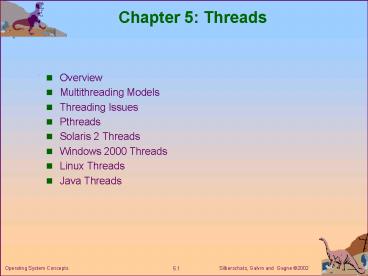Chapter 5: Threads - PowerPoint PPT Presentation
1 / 21
Title:
Chapter 5: Threads
Description:
Thread management done by user-level threads library. The library provides support for ... or duplicates only the thread that involved the fork system call. ... – PowerPoint PPT presentation
Number of Views:37
Avg rating:3.0/5.0
Title: Chapter 5: Threads
1
Chapter 5 Threads
- Overview
- Multithreading Models
- Threading Issues
- Pthreads
- Solaris 2 Threads
- Windows 2000 Threads
- Linux Threads
- Java Threads
2
Single and Multithreaded Processes
- Thread a lightweight process (LWP) , a basic
unit of CPU utilization
3
Benefits
- Responsiveness
- Multithreading an interactive application may
allow a program to continue running even if part
of it is blocked or is performing a lengthy
operation. - Resource Sharing
- By default, threads share the memory and the
resources of processes to which they belong. - Economy
- Allocating memory and resources for process
creation is costly. - It is more economical to create and context
switch threads. - Utilization of MP Architectures
- In a multiprocessor architecture, each thread
may be running in parallel on a different
processor
4
User Threads
- Thread management done by user-level threads
library - The library provides support for thread
creation, scheduling, and management with no
support from kernel. - Examples
- - POSIX Pthreads
- - Mach C-threads
- - Solaris threads
5
Kernel Threads
- Supported by the Kernel (OS)
- Examples
- - Windows 95/98/NT/2000
- - Solaris
- - Tru64 UNIX
- - BeOS
- - Linux
6
Multithreading Models
- Many-to-OneMaps many user-level threads to one
kernel thread. - One-to-OneMaps each user-level thread to a
kernel thread. - Many-to-Many
- Multiplexes many user-level threads to a small
or equal number of kernel threads.
7
Many-to-One
- Many user-level threads mapped to single kernel
thread. - Used on systems that do not support kernel
threads. - Thread management is done in user space
- It is efficient
- The entire process will block if a thread makes a
blocking system call - Multiple threads are unable to run in parallel on
multiprocessors.
8
Many-to-One Model
9
One-to-One
- Each user-level thread maps to a kernel thread.
- Creating a user thread requires creating the
corresponding kernel thread. - The number of threads supported by the system is
restricted. - Examples
- - Windows 95/98/NT/2000
- - OS/2
10
One-to-one Model
11
Many-to-Many Model
- Allows many user level threads to be mapped to
many kernel threads. - Allows the operating system to create a
sufficient number of kernel threads. - Solaris 2
- Windows NT/2000 with the ThreadFiber package
12
Many-to-Many Model
13
Threading Issues
- Semantics of fork() and exec() system calls.
- Fork() duplicates all threads or duplicates only
the thread that involved the fork system call. - Exec() the program specified in the parameter to
the exec will replace the entire process. - Thread cancellation.
- Asynchronous cancellation One thread immediately
terminates the target thread. - Deferred cancellation The target thread can
periodically check if it should terminate.
cancellation points
14
Threading Issues (cont.)
- Signal handling
- A signal is generated by the occurrence of a
particular event. - A generated signal is delivered to a process.
- Once delivered, the signal must be handled.
- -- Deliver the signal to the thread to which the
signal applies. - -- Deliver the signal to every thread in the
process. - -- Deliver the signal to certain threads in the
process. - -- Assign a specific thread to receive all
signals for the process. - Thread pools
- to create number of threads at process startup
and place them into a pool. - Thread specific data
15
Pthreads
- a POSIX standard (IEEE 1003.1c) API for thread
creation and synchronization. user-level thread
library - API specifies behavior of the thread library,
implementation is up to development of the
library. - Common in UNIX operating systems.
16
Solaris 2 Threads
Solaris 2 a version of UNIX with Support for
threads at the kernel and user
levels, SMP, and real-time scheduling.
17
Solaris Process
18
Windows 2000 Threads
- Implements the one-to-one mapping.
- Each thread contains
- - a thread id
- - register set
- - separate user and kernel stacks
- - private data storage area ( used by various
run-time - libraries and dynamic link libraries (DLLs).
19
Linux Threads
- Linux refers to them as tasks rather than
threads. - Thread creation is done through clone() system
call. - Clone() allows a child task to share the address
space of the parent task (process)
20
Java Threads
- Java threads may be created by
- Extending Thread class
- Implementing the Runnable interface
- Java threads are managed by the JVM.
21
Java Thread States































